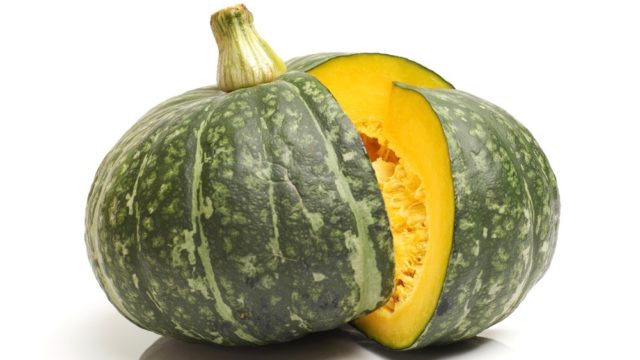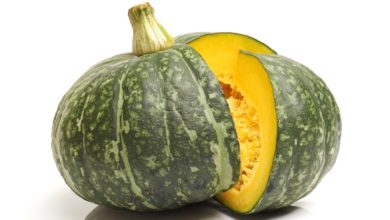 Scroll down to watch the step-by-step video.
Scroll down to watch the step-by-step video.
Kabocha Squash is a Japanese variety of winter squash that is becoming very popular these days, and seemingly, much easier to find.
They have a round squat shape with a hard, knobby exterior, and rich dark green skin. On the inside you will find a beautiful yellow-orange flesh and seeds that are very similar to pumpkin seeds.
Flavor
The flavor is sweet, slightly nutty and the texture is light, almost fluffy. I’ve actually heard people describe it as a cross between a pumpkin and a sweet potato and I would have to agree that that’s a pretty accurate description.
Season
Because Kabocha’s are a winter squash, you’ll usually start seeing them pop up around October and then last throughout February or March.
Nutritional Benefits
That rich orange color lets us know that Kabocha is an excellent source of beta carotene and it’s also high in fiber and loaded with iron, vitamin C and some B vitamins.
A single cup of kabocha has just forty calories and 7 grams of carbohydrates which is about half of what you would find in a butternut squash.
So it’s both a delicious and nutritious addition to just about any type of diet. #WINWIN
Shopping
When you are shopping for your Kabocha squash, you want to look for a squash that feels heavy for its size. The skin will be dull and bumpy (thats normal) you just want to be sure there are no soft spots.
Storing
Once you get your squash home, simply store it on a cool dry place. I usually leave mine right on the counter and it will easily last up to a month (but that will never happen because you are going to be so excited to eat it).
Preparation
When you are ready to work with your squash, give it a good rinse under some cold water and then grab a nice heavy sharp knife. Because it has a tough skin they can be tough to cut – so you want to be careful. Start by cutting it right down the middle. Get your weight over the top of the squash and then gently rock back and forth.
**PRO TIP** If you want to soften the skin before cutting, place the squash in the microwave for 2-4 minutes (depending on the size). This will make cutting into your squash a lot easier.
Once you have it open you will see, that it has seeds inside, just like a pumpkin. These seeds can be roasted and eaten just like pumpkin seeds, so once you scoop them out be sure to save them if you want a yummy snack.
Now if you want to keep your cutting to a minimum, you can stop right here, place the squash flesh side down on a rimmed baking sheet and bake at 400 for about 25-30 minutes and your squash would be cooked and ready to go.
You could season the flesh with a little cinnamon and honey if you wanted a sweeter version or you can do a little salt and pepper and garlic powder or curry powder for a more savory flavor.
Another options is to fill the cavity with some salad and eat it that way OR scoop out the flesh and us it in a soup, a smoothie, or really any where you would use pumpkin puree.
SO that’s one option.
If you don’t mind continuing to cut your squash, then this is definitely my personal favorite way of eating it.
Take each half and cut them into wedges just like you would if you were cutting a melon.
Then I toss with a little olive oil, salt, pepper, garlic powder and curry powder. Now again, if you wanted a sweet flavor swap the garlic and curry for some cinnamon or even a little pumpkin pie spice, both would be delish.
Transfer to a rimmed baking sheet and roast at 400 degrees for about 20 minutes flipping it half way through.
The goal is to get this beautiful golden brown flesh with a nice tender skin, because remember, the skin is 100% edible. Its softens up when it cooks and is delicious.
You can of course, eat this exactly as is and snack a way, serve it a long side some roasted chicken or fish, or use it to top off a beautiful winter salad. The options are endless.
Some Kabocha Squash Recipes That Have My Mouth Watering:
- Soy Braised Kabocha Squash from Savuer
- Stuffed Kabocha Squash from The Detoxinista
- Sweet and Spicy Kabocha Squash from Food
- Roasted Kabocha Squash Soup from Goop



Comments
Patti hughes says
I use in my chicken soup to replace potatoes so yummy!
Dani says
Great idea!
D_Rod11 says
Is the inside of the squash suppose to be hard. My first time cooking it.
Dani says
No. It should be tender on the inside.
Valrose MotleyBarnes says
It’s also delicious when added to curry shrimp. I love it in rice.
Janet DeWoskin says
Kabocha is the only winter squash I like, actually I love kabocha!, and your recipe is terrific. I do have one question though – sometimes I find kabocha with hard, dry bumps on their skin that remind me of barnacles. Do you know what causes them, and what recommendations you have to cookie/eating them?
Dani says
I have had that happen as well. I’m not sure what causes it but I always cut them off after cooking. You cut it before cooking, it’s just a little trickier.
Dawn O DeSimone says
Question: My squash was so hard to cut, I roasted it for one hour at 400 degrees. The squash was split at the top, and I was able to easily insert a knife through the skin allover. However, once it cooled a bit, I scooped the the flesh out, but it seemed to firm up, especially the part right against the skin. I want to use it in a pie – should I bake it in a covered dish some more? Thank you!
Dani says
Hi Dawn, I would definitely rebake for a bit if you need it to be soft enough for a pie 🙂
Sarah says
I steamed my squash and for some reason it came out powdery and dry. This is my favorite squash I have no idea why this happened and I’m gonna have to toss it in the trash. Any idea why this could’ve happened?
Dani Spies says
Hmmmm, I know that some kabocha squash can be a bit drier but I’m not sure why it was powdery. Perhaps it needed a bit of fat to help it along – like a good quality olive oil
Jennifer says
I add Kabocha to japanese Curry! SO GOOD
Jim says
When I looked up Kabocha on Wikipedia it said:
Ripeness
When kabocha is just harvested, it is still growing. Therefore, unlike other vegetables and fruits, freshness is not as important. It should be fully matured first, in order to become flavorful, by first ripening the kabocha in a warm place (77 °F/25 °C) for 13 days to convert some of the starch to sugar. Then the kabocha is transferred to a cool place (50 °F/10 °C) and stored for about a month in order to increase carbohydrate content. In this way, the just-harvested, dry, bland-tasting kabocha is transformed into a smooth, sweet kabocha. Fully ripened, succulent kabocha will have reddish-yellow flesh, a hard skin, and a dry, corky stem. It reaches the peak of ripeness about 1.5–3 months after it is harvested.
Is this how you purchase them at the store?
Dani Spies says
Yep! They are delicious.
Laura says
Great recipe but I am finding that when I bake there is a wax put on the skin that makes it unpleasant to eat sometimes. What is the best way to remove this wax before eating? Thank you
Dani Spies says
I would try washing he squash under some warm water before hand.